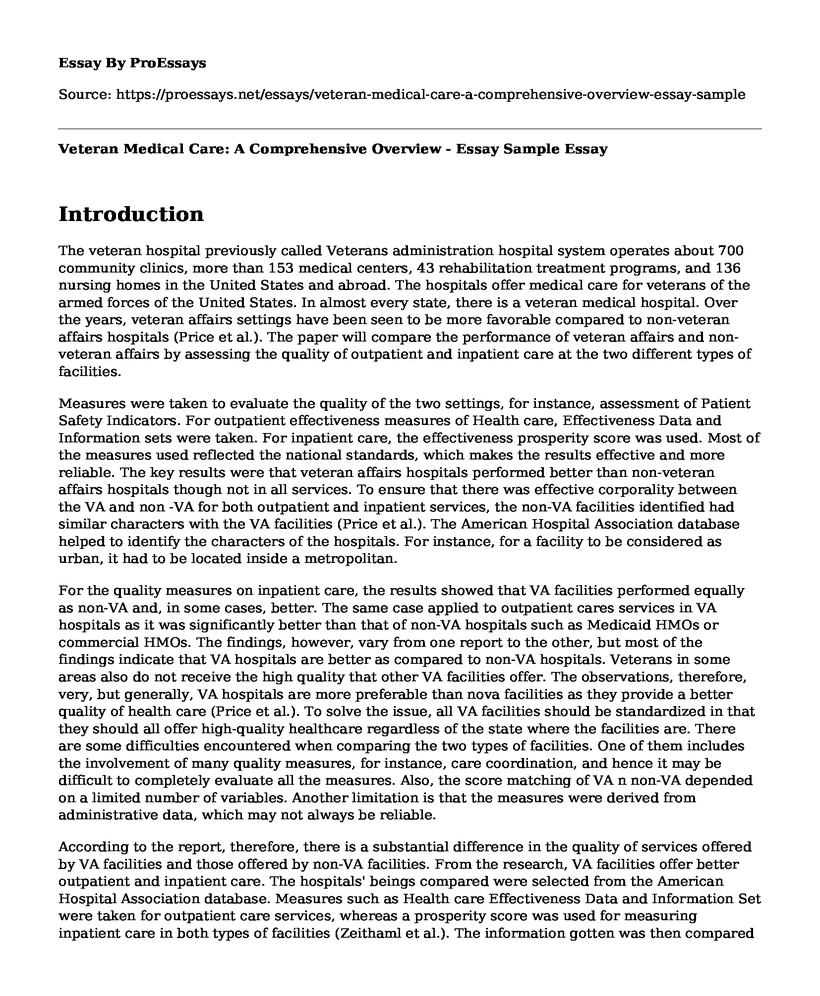Introduction
The veteran hospital previously called Veterans administration hospital system operates about 700 community clinics, more than 153 medical centers, 43 rehabilitation treatment programs, and 136 nursing homes in the United States and abroad. The hospitals offer medical care for veterans of the armed forces of the United States. In almost every state, there is a veteran medical hospital. Over the years, veteran affairs settings have been seen to be more favorable compared to non-veteran affairs hospitals (Price et al.). The paper will compare the performance of veteran affairs and non-veteran affairs by assessing the quality of outpatient and inpatient care at the two different types of facilities.
Measures were taken to evaluate the quality of the two settings, for instance, assessment of Patient Safety Indicators. For outpatient effectiveness measures of Health care, Effectiveness Data and Information sets were taken. For inpatient care, the effectiveness prosperity score was used. Most of the measures used reflected the national standards, which makes the results effective and more reliable. The key results were that veteran affairs hospitals performed better than non-veteran affairs hospitals though not in all services. To ensure that there was effective corporality between the VA and non -VA for both outpatient and inpatient services, the non-VA facilities identified had similar characters with the VA facilities (Price et al.). The American Hospital Association database helped to identify the characters of the hospitals. For instance, for a facility to be considered as urban, it had to be located inside a metropolitan.
For the quality measures on inpatient care, the results showed that VA facilities performed equally as non-VA and, in some cases, better. The same case applied to outpatient cares services in VA hospitals as it was significantly better than that of non-VA hospitals such as Medicaid HMOs or commercial HMOs. The findings, however, vary from one report to the other, but most of the findings indicate that VA hospitals are better as compared to non-VA hospitals. Veterans in some areas also do not receive the high quality that other VA facilities offer. The observations, therefore, very, but generally, VA hospitals are more preferable than nova facilities as they provide a better quality of health care (Price et al.). To solve the issue, all VA facilities should be standardized in that they should all offer high-quality healthcare regardless of the state where the facilities are. There are some difficulties encountered when comparing the two types of facilities. One of them includes the involvement of many quality measures, for instance, care coordination, and hence it may be difficult to completely evaluate all the measures. Also, the score matching of VA n non-VA depended on a limited number of variables. Another limitation is that the measures were derived from administrative data, which may not always be reliable.
According to the report, therefore, there is a substantial difference in the quality of services offered by VA facilities and those offered by non-VA facilities. From the research, VA facilities offer better outpatient and inpatient care. The hospitals' beings compared were selected from the American Hospital Association database. Measures such as Health care Effectiveness Data and Information Set were taken for outpatient care services, whereas a prosperity score was used for measuring inpatient care in both types of facilities (Zeithaml et al.). The information gotten was then compared and established that VA hospitals were better as they provided a better quality of health care services. Some of the limitations of the report were that the quality measures are many, and hence not all of them were exhausted. Also, the measures and standardized characteristics required were derived from an administration database, which may not be reliable.
Works Cited
Price, Rebecca Anhang, et al. "Comparing the quality of care in Veterans Affairs and non-Veterans Affairs settings." Journal of general internal medicine 33.10 (2018): 1631-1638.
Zeithaml, Valarie A., Leonard L. Berry, and Arantharanthan Parasuraman. "The nature and determinants of customer expectations of service." Journal of the Academy of Marketing Science 21.1 (1993): 1-12.
Cite this page
Veteran Medical Care: A Comprehensive Overview - Essay Sample. (2023, May 18). Retrieved from https://proessays.net/essays/veteran-medical-care-a-comprehensive-overview-essay-sample
If you are the original author of this essay and no longer wish to have it published on the ProEssays website, please click below to request its removal:
- Statistics for the Behavioural Sciences Paper Example
- Paper Example on Sports Massage Profession
- My Career Choice: Nursing Paper Example
- Essay Sample on the Use of Antibiotics in Food and Its Effects
- Essay on Pursuing Clinical Embryology: My Drive to Help Reproductive Patients
- Paper Example on Designing Facilities for Optimal Healthcare: Stakeholder Perspectives
- My Personal Nursing Philosophy - Free Essay Example







